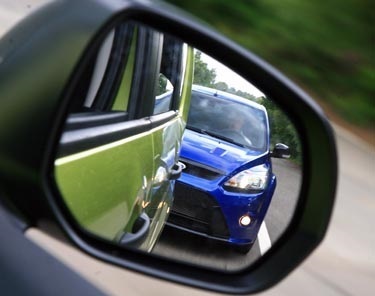Its What's Behind You That Can Hurt
 |
Keep checking rearview mirror to avoid damage to your vehicle, expert warns
- A new study has identified the most common type of crash that damages vehicles and their contents, with rearview collisions the main cause.
- The study analyzed NHTSA data on Property Damage Only (PDO) motor vehicle crashes to determine what manner these are most likely to occur.
- Americans have to worry the most on a Friday about an accident which results in harm to their cars or possessions inside.
- An expert at The Barber Law Firm advises on what to do to ensure you get the financial compensation you deserve following a PDO crash.
A law expert has urged drivers to be extra cautious of the traffic traveling behind them, as cars and their belongings are most at risk of being damaged by another vehicle hitting the back of them.
The study, conducted by the legal team at The Barber Law Firm, analyzed National Highway Traffic Safety Administration (NHTSA) data on Property Damage Only (PDO) motor vehicle crashes between 2017 and 2021 to identify the manner these are most likely to occur.
The research found that Americans should be extra vigilant of motorists driving behind them if they want to avoid the stress of a potentially hefty bill.
A whopping 7,019,190 of the PDO crashes that occurred over the five-year period were rear-end collisions - nearly a third (32%) of the 22,100,325.
This is perhaps an indication that people don't pay enough attention to the vehicles in front of them, which results in them colliding into the back of them, for example, if they don't notice the car slowing down or breaking suddenly.
Interestingly, the second most likely manner in which a PDO crash happens is without a motor vehicle in transport, with 6,563,467 (30%) PDO crashes taking place this way between 2017 and 2021.
This includes unfortunate situations such as if a strong wind stirs up rocks, which then land on your car and dent the exterior or smash the windscreen.
While drivers can try to decrease the chance of a car crashing into their rear by taking precautions, such as adhering to the 3-second rule for the amount of distance required between cars, there isn't much that can be done to avoid bad luck.
The third most common manner of a PDO crash is an angle collision, which occurred 4,357,313 (20%) times over the five years analyzed.
The study also revealed Fridays are the worst time of the week for PDO Crashes. Of the total between 2017 and 2021, 3,765,030 happened on a Friday, which accounts for nearly a fifth (17%), possibly because drivers were distracted in their rush to get home for the weekend.
In comparison, vehicles and any personal items stored are least at risk on Sundays, which recorded 2,262,407 PDO crashes, which is just 10% of the total PDO crashes.
Days ranked by number of PDO crashes
|
Rank |
Day |
Total number of PDO motor vehicle crashes (2017 - 2021) |
|
1. |
Friday |
3,765,030 |
|
2. |
Thursday |
3,445,377 |
|
3. |
Wednesday |
3,377,151 |
|
4. |
Tuesday |
3,372,785 |
|
5. |
Monday |
3,171,210 |
|
6. |
Saturday |
2,706,407 |
|
7. |
Sunday |
2,262,407 |
Surprisingly, lack of visibility due to dark nights doesn’t appear to increase the likelihood of a PDO crash. There were 15,419,723 PDO crashes in the daytime, which makes up almost three-quarters (70%) of the total across the time frame studied.
Commenting on the findings, a spokesperson from The Barber Law Firm says:
“It’s interesting that PDO motor vehicle crashes increase as we move through the weekdays from Monday to Friday, and then significantly drop on Saturday and Sunday.
“These figures could reflect the higher amount of traffic on the roads during the week from those that work typical 9 to 5 jobs, and how the stress of a workday impacts their concentration.
"If you are unlucky enough to be involved in one, it can be tough to know what property you can claim financial compensation on and it might be more than you think.
"Consider any costs that will impact your finances. If you kept tools in your car that are now unusable and you will have to replace, these can be added to your claim."


